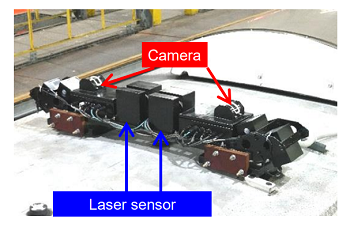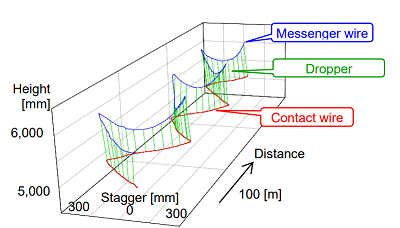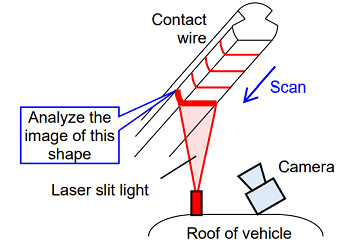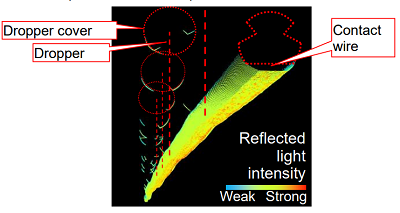14. Overhead contact line measurement device using 3D measurement and image analysis
A contactless overhead contact line measurement device that is mounted on the roof of an electric inspection car and a commercial line vehicle to inspect the installation condition of wires for overhead contact lines (contact wire, messenger wire, and other wires) and fittings (droppers, connectors, and other fittings), as well as a contact wire wear measuring method using a light-section method to realize high-precision measurement with a compact device have been developed.
A contactless overhead contact line measurement device (Fig. 1) is used to measure the 3D position and the shape of each wire and fitting using a combination of image analysis and laser measurement.
The results of a trial measurement using this device mounted on the roof of a conventional line vehicle traveling at speeds of up to 130 km/h, confirmed that the height and horizontal stagger of a contact wire could be obtained within a precision of +/-10 mm in repeated measurements; and that more than 90 % of droppers could be extracted automatically from the images (Fig. 2). As this device can record the condition of an overhead contact line facility in both numerical values and images, it is possible not only to inspect the difference in height of overhead crossing lines and the tension on a messenger wire, but also to diagnose abnormalities such as deformation of fittings.
A contact wire wear measuring method using the light-section method is used to measure the 3D shape of the lower half of a contact wire by image analysis using the shape of a laser slit light irradiated onto the contact wire (Fig. 3), and enables high-precision wear measurement regardless of the condition of the sliding surface. The results of a verification test conducted by mounting the experimental device on the roof of a Shinkansen vehicle (Fig. 4), confirmed that the residual diameter of a contact wire could be measured with an accuracy of better than +/-0.1 mm on average.
Accordingly, this method can eliminate any deterioration in the accuracy of the measurement of the residual diameter of contact wires, caused by uneven wear and burrs on sliding surfaces.




